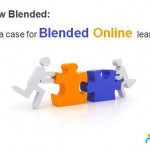New Blended Learning: a case for online blended
Posted March 29th, 2011 by KiyomidCategories: Teaching a language
 New Blended Learning: a case for online blended
New Blended Learning: a case for online blended
Breaking the compromise between individualization and convenience
Brief Intro to Traditional learning:
In the past, the most trusted way to learn was by going to a school, or have a teacher come to the location of the student. That is what we call the traditional learning. The main advantages are that the classes are individualized and built around the students’ needs, level, speed of progress and more. However, this requires students and teachers to be present in the same place at the same time, with the disadvantage of commuting for both the teacher and student, physical space management (which is often a very large expense for schools) and location constraints since a student can only choose what is offered nearby and you can only study during times close to business hours. Also, students are restricted to a limited selection of teachers or schools within a reasonable distance from their homes / workplaces.
On the other side, we have asynchronous learning: which could be the book bought at the airport, audio lessons, text books, audio or multimedia and more. This is learning which can be done anytime, anywhere, at the student’s own pace. One of the largest problems with the asynchronous learning though is that it’s not individualized or personalized, as it’s built to suit a large mass of students. It lacks therefore the critical interaction between students and teachers
To solve this trade-off between individualization and convenience, educators have tried to combine both: offering students face-to-face lessons and using one of the asynchronous learning resources for self-study.
The downside of this kind of blended learning is that they are not built together. Therefore combining them ad hoc often requires the compromise between the interest of the asynchronous content provider and that of the synchronous school or educator. The result is a learning experience with good base resources, but one that does not reach the full potential of the publisher and the educator.
We have all learned this way, by going to schools, universities and always having at least one textbook for every class. The new generations now are even lucky to have e-books and avoid those memories of back pains and huge backpacks…
The new blended learning:
As broadband and VOIP penetration keep increasing, the internet brings new solutions that were previously not possible in the area of education and e-learning, fully integrating the traditional and asynchronous learning into a New Blended Learning.
To explain more on how it works, we will use the real case example of Myngle and Instituto Cervantes.
Myngle is Europe’s leading multi-language online school, offering 45 languages with 200 highly selected and trained teachers out of a pool of more than 6.000 applicants. 95% of students rate their classes as excellent, which proves that live online learning works.
Instituto Cervantes is backed by the Spanish foreign ministry and provides extensive Spanish online learning courses with officially recognized certificates. With over 20 years of experience developing courses, Instituto Cervantes has proven to be an excellent asynchronous learning material.
The combination of two very different education companies is what makes it interesting:
1 – Myngle, provides individualized online lessons, with 100% flexibility, since students can choose their teacher and time to learn. But, as a language school, it is not a content publisher.
2 – Instituto Cervantes provides proven high quality content and officially recognized certificates, but this content lacks the personalization to really fit to the specific student’s needs.
By Myngle joining forces with Instituto Cervantes, the student can have the best of both: individualized lessons and live practice through Myngle built on the content from Instituto Cervantes, and with diplomas recognized worldwide.
To make this learning truly blended, Myngle teachers went through a special training made by Instituto Cervantes based on its content. With that, the publisher and educator work hand-in-hand to ensure that the content is used in its fullest potential and the student has maximum learning results. The goal is to achieve high effectiveness and efficiency.
The results:
Feedback from students and teachers that took part in this pilot is very positive.
Students feel more comfortable and confident learning and speaking, as they see that they are progressing in their Spanish fast, and are therefore continuing to the next levels.
Some teachers see that they can offer not only a successful foreign language learning solution to their students, but also use their own experience to create the best possible learning experience. This achieved through personalized live lessons and through creating additional content adapted for the lessons.
The Future ahead
If we look at the future of the New Blended Learning, we see that there are some short term issues and questions which still needs to be addressed for an efficient use of this new solution.
•   From the educators’ perspective:
Teachers will have to find their role, as this new learning solution requires a different approach than the traditional methods. The main question is whether teachers will take an active role, bringing their expertise and helping shaping the new courses, or they will simply follow, and use what’s offered to them.
Publishers will also have to adapt their role as content developers. So far, the content provided by publishers focuses only on either synchronous or asynchronous. Publishers’ main contribution usually stops once the content is produced and distributed, giving the teachers and schools the responsibility to become familiar with their content.
•   From the students’ perspective:
Main issues here are related to the use of technology and adoption of new technology solutions.
Computer phobia – many students don’t feel comfortable enough using the technology in such an intensive way, and may take some time to get used to it.
Minimum infrastructure requirements – students taking live online classes will require a fast broadband connection with hardware capable of handling voice and video (optional) communication.
Set-up learning curve – going inside a school and taking face-to-face classes is quite familiar to everyone; however having the same experience through a web service where the student must navigate to book his/her own classes (and reschedule) can be complex for some.
Looking at the longer term future, some strategic questions for all educators will need to be tackled in order to make it a lasting success and a new standard in education
o   What is the role of the teacher in online blended?
o   Does asynchronous format need to be rethought?
o   What is the role of the traditional school in a fully
online environment?
We welcome the input from all educators here regarding these issues and what they see as the real ’future’ of language education.
 ynglers,
ynglers,
 Mynglers,
Mynglers, going to give a presentation about “Blended Online Learning”.
going to give a presentation about “Blended Online Learning”.


